Oral PEY Treatment Induces Hair Regrowth and Improves Hair Quality in Patients with Alopecia
Introduction
Egg-yolk-based supplement have proven several biological beneficial effects and can be found in the market divided into unfertilized (commercialized) and fertilized. Scientific data demonstrated that eggs contain active compounds that may have a role in the therapy and prevention of chronic and infectious diseases. Although there is no currently scientific evidence to demonstrate it, eggs has been traditionally recommended for skin and hair problems and people have reported significant benefits after using eggs in their masks. However, the use of egg-yolk as a treatment of hair problems has stopped being used due to the appearance of more specific drugs and procedures to prevent hair loss and to improve hair regrowth. Among the most used procedures to combat hair loss nowadays, the transplant of hair with the FUE (follicular extraction unit) technique, is an innovative micrograft in which the hair follicles are transplanted together with all the perifollicular structures (including the blood vessels, the sebaceous gland or the piloerector muscle, among others) [1]. Furthermore, the major part of currently available conventional treatments are non-specific broad immunosuppressants administered locally or systemically, including topical and intralesional corticosteroids [2]. These treatments however are associated with multitude side effects such as skin atrophy, striae and telangiectasias, and even adrenal suppression, insomnia and glucose intolerance [3]. Other randomized controlled components under study include JAK inhibitors, such as tofacitinib, rollatini and baricite; fumaric acid esters; inhibitors of phosphodiesterases like apremilast; PGF2 analogs as Bigatures and Sterilant [4]. Nevertheless, in general, treatment of hair loss is often difficult and frustrating to patients and clinicians owing to the limited efficacy, the slow growth rate of hair and sometimes the adverse side effects.
In this study, we want to test the putative beneficial effects of our recently patented complement, PEY, in hair loss. PEY consists of an egg preparation obtained through a patented process from the fertilized egg-yolk [5]. A potent anti-inflammatory effect of PEY treatment has been recently reported in vivo [6]. Among the multitude of PEY components, highlight the presence of growth factors such as connective tissue growth factor (CTGF), platelet-derived growth factor (PDGF), and insulin-like growth factor (IGF-1) [6]; all of them with proven beneficial effects in the growth of hair follicles [7,8] Also, PEY exhibits a differential lipidomic and metabolomic profile with lipids clustered among different sphingolipid-related and immune-related pathways, and metabolites present in pathways related to omega-3 fatty acids, among others [6]. In addition to test PEY administration alone, we also want to analyze the putative efficacy of PEY to act as a booster with the most common-used treatments for alopecia.
Methods
All procedures and visits were conducted in accordance with the Guideline for Good Clinical Practice of the Institute Vila- Rovira. The study duration was around 4 months within which each volunteer (total of 45 patients) with alopecia was orally administered with 6 pills of PEY once a day. One group of patients (21 patients) only received PEY, whereas in the other group (24 patients) the PEY treatment was administered together with their usual treatment for allopecia. The PEY treatment consists of an egg preparation obtained through a patented process [5]. It comprises a mixture of yolk and white extracted from a fertilized egg that has been incubated for a short period, which then is lyophilized to obtain a commercial product called Excelvit. Qualitative analysis of the efficacy of PEY administration was determined by changes in global photography and with a satisfactory survey for each patient.
Results
Forty-Five Patients with a Clinical Diagnosis of Alopecia Were Enrolled in the Study
In the first group of patients (21 patients) PEY was administered alone to evaluate the efficacy of the product in alopecia. From this group, a total of 14 patients from the 18 that complete the treatment (77.7%) experimented a substantial improvement ranging from the stop in the hair loss to a better quality of the hair and skin. Notably, this effectiveness was higher in women than in men (86.41% vs 80%) (Table 1). In the second group of patients (24 patients) PEY was administered together with the usual alopecia’s treatment of the patient to analyze whether PEY can act as a booster to complement other treatments. In this case, from the 17 patients that complete the study 12 (70.58%) experimented an improvement of their condition ranging from hair regrowth Figure 1, stop of the hair loss Figures 2-4 and better quality of the hair Figure 3. Again, the efectiveness reported was higher in women than in men (76.92% vs 50%) (Table 1 and Figures 1,3,4). No side effects were detected by any of the patients in any treatment regimen along the study.
Figure 1: Patient demonstrated significant hair regrowth after the FUE transplant and PEY administration. This beneficial effect progressively continued up to 10 months of PEY treatment.
Figure 2: Patient after 3 months of treatment with PEY administered together with his conventional treatment for alopecia (PRP + Trichosol + Minoxidil 5%-F1% + Vit + Dutasteride). The patient experimented a reduction of hair loss, capillar regeneration and a faster hair growth. Also, the treatment provokes and increase in body weight.
Figure 3: Patient after 3 months of treatment with PEY administered together with her conventional treatment for alopecia (PRP + CAP Vitamin + Minoxidil 5%-F1%). The patient experimented a significant sttoping of the hair loss, capillar regeneration, a faster hair growth and a better hair texture.
Figure 4: Patient after 3 months of treatment with PEY administered together with her conventional treatment for alopecia (PRP + CAP Vitamin + Iraltone AGA plus). The patient experimented a complete sttoping of the hair loss.
Discussion and Conclusion
Our findings demonstrated that PEY treatment has a role in the treatment of alopecia. This treatment is effective when administered as a complement to conventional treatments for alopecia, but interestingly it has also a potent regrowing effect when administered alone. The anti-inflammatory effects already described for PEY, together with the higher CNTF and IGF-1 expression observed in cells treated with this compound, pointed to this molecule as potential candidates below the beneficial effects observed in patients (Cunill et al. Nutrients 2020). Indeed, both CNTF and IGF-1 has been linked to hair follicle growth and preservation [7,8]. Another highlighted point of this study is that the 73.3% of patients enrolled are woman, contrary to most of the studies of new drugs for alopecia that are focus exclusively or majority on men. Interestingly, the effects are proportionally higher in women than in men indicating that the hormonal control is one important aspect to take into account in the generation of new drugs. Remarkably, in contrast to major part of actual treatments for alopecia [2], no side effects were observed in any patient, probably due to the 100% natural origin of PEY.
In conclusion, this is an important study pointing towards the natural nutritional component PEY as a promising oral treatment for alopecia in both women and men and without any adverse side-effect. This study is in line with a growing data indicating that the food complements (like omega-3, curcumin, honey...) have a therapeutic effect through their anti-inflammatory and regenerative actions [9-13]. In this sense, it is essential that this compound will be introduced in the clinical practice, to increase the efficacy of human treatments, as will improve the general antiinflammatory state of the patients leading to a better resolution of medical interventions.
For more Articles on: https://biomedres01.blogspot.com/
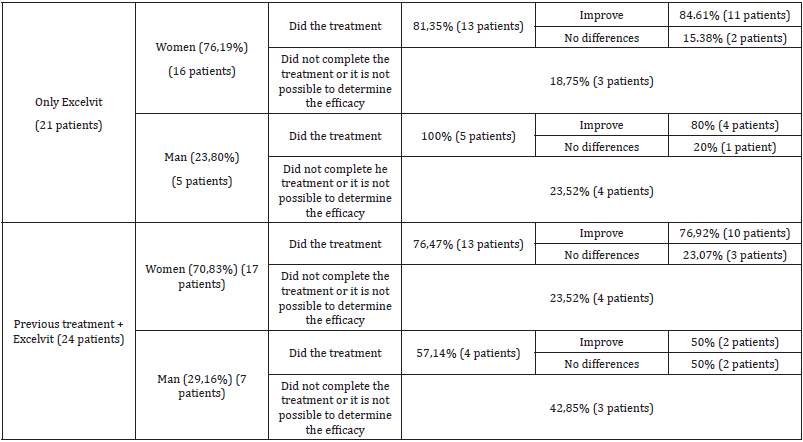
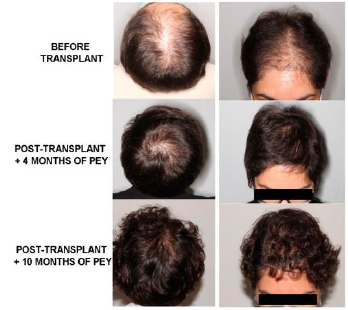
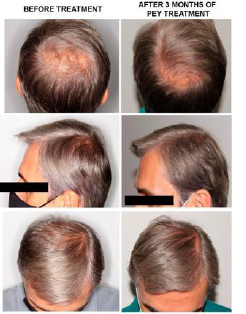
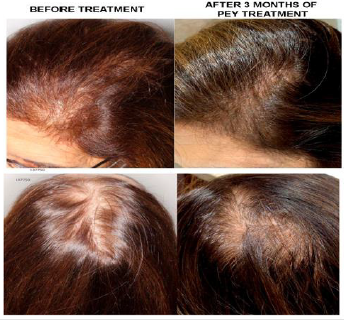
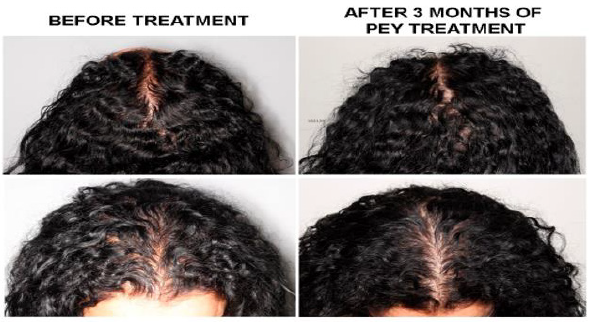


No comments:
Post a Comment
Note: Only a member of this blog may post a comment.